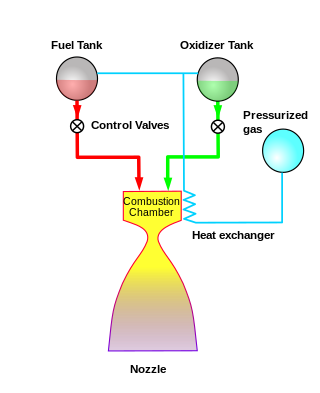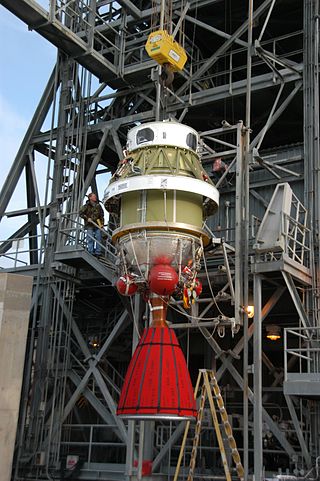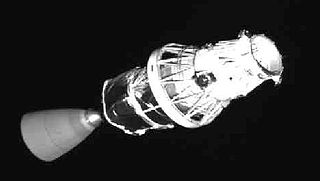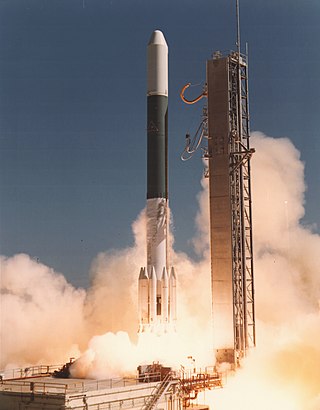
The Apollo Lunar Module, originally designated the Lunar Excursion Module (LEM), was the lunar lander spacecraft that was flown between lunar orbit and the Moon's surface during the United States' Apollo program. It was the first crewed spacecraft to operate exclusively in the airless vacuum of space, and remains the only crewed vehicle to land anywhere beyond Earth.

Delta II was an expendable launch system, originally designed and built by McDonnell Douglas, and sometimes known as the Thorad Delta 1. Delta II was part of the Delta rocket family, derived directly from the Delta 3000, and entered service in 1989. There were two main variants, the Delta 6000 and Delta 7000, with the latter also having "Light" and "Heavy" subvariants. During its career, Delta II flew several notable payloads, including 24 Global Positioning System (GPS) Block II satellites, several dozen NASA payloads, and 60 Iridium communication satellites. The rocket flew its final mission, ICESat-2, on 15 September 2018, earning the launch vehicle a streak of 100 successful missions in a row, with the last failure being GPS IIR-1 in 1997. In the late 1990s, Delta II was developed further into the unsuccessful Delta III, which was in turn developed into the more capable and successful Delta IV, though the latter shares little heritage with the original Thor and Delta rockets.

The Delta rocket family was a versatile range of American rocket-powered expendable launch systems that provided space launch capability in the United States from 1960 to 2024. Japan also launched license-built derivatives from 1975 to 1992. More than 300 Delta rockets were launched with a 95% success rate. The series was phased out in favor of the Vulcan Centaur, with the Delta IV Heavy rocket's last launch occurring on April 9, 2024.

The N1/L3 was a super heavy-lift launch vehicle intended to deliver payloads beyond low Earth orbit. The N1 was the Soviet counterpart to the US Saturn V and was intended to enable crewed travel to the Moon and beyond, with studies beginning as early as 1959. Its first stage, Block A, was the most powerful rocket stage ever flown for over 50 years, with the record standing until Starship's first integrated flight test. However, each of the four attempts to launch an N1 failed in flight, with the second attempt resulting in the vehicle crashing back onto its launch pad shortly after liftoff. Adverse characteristics of the large cluster of thirty engines and its complex fuel and oxidizer feeder systems were not revealed earlier in development because static test firings had not been conducted.

The RL10 is a liquid-fuel cryogenic rocket engine built in the United States by Aerojet Rocketdyne that burns cryogenic liquid hydrogen and liquid oxygen propellants. Modern versions produce up to 110 kN (24,729 lbf) of thrust per engine in vacuum. Three RL10 versions are in production for the Centaur upper stage of the Atlas V and the DCSS of the Delta IV. Three more versions are in development for the Exploration Upper Stage of the Space Launch System and the Centaur V of the Vulcan rocket.

The pressure-fed engine is a class of rocket engine designs. A separate gas supply, usually helium, pressurizes the propellant tanks to force fuel and oxidizer to the combustion chamber. To maintain adequate flow, the tank pressures must exceed the combustion chamber pressure.

The Space Launch Initiative (SLI) was a NASA and U.S. Department of Defense joint research and technology project to determine the requirements to meet all the nation's hypersonics, space launch and space technology needs. It was also known as the "2nd Generation Reusable Launch Vehicle (RLV) program.". The program began with the award of RLV study contracts in 2000.

Soyuz 7K-L1 No.5L, sometimes identified by NASA as Zond 1967B, was a Soviet spacecraft which was launched in 1967 as part of the Zond programme. It was a 5,390-kilogram (11,880 lb) Soyuz 7K-L1 spacecraft, the second of nine to be launched. It was intended to perform a circumlunar flyby of the Moon before returning to the Earth for landing, but failed to achieve Earth orbit.

The AJ10 is a hypergolic rocket engine manufactured by Aerojet Rocketdyne. It has been used to propel the upper stages of several launch vehicles, including the Delta II and Titan III. Variants were and are used as the service propulsion engine for the Apollo command and service module, in the Space Shuttle Orbital Maneuvering System, and on the European Service Module – part of NASA's Orion spacecraft.

The Delta-K was an American rocket stage, developed by McDonnell Douglas and Aerojet. It was first used on 27 August 1989 as the second stage for the Delta 4000 series.

The pintle injector is a type of propellant injector for a bipropellant rocket engine. Like any other injector, its purpose is to ensure appropriate flow rate and intermixing of the propellants as they are forcibly injected under high pressure into the combustion chamber, so that an efficient and controlled combustion process can happen.

The Delta 1000 series was an American expendable launch system which was used to conduct eight orbital launches between 1972 and 1975. It was a member of the Delta family of rockets. Several variants existed, differentiated by a four digit numerical code. Delta 1000 was developed by McDonnell Douglas company in 1972.

The Delta 2000 series was an American expendable launch system which was used to conduct forty-four orbital launches between 1974 and 1981. It was a member of the Delta family of rockets, sometimes called Thorad Delta. Several variants existed, which were differentiated by a four digit numerical code. The Delta 1000, 2000 and 3000 series used surplus NASA Apollo program rockets engines for its first and second stages.
Advanced Gemini was a series of proposals that would have extended the Gemini program by the addition of various missions, including crewed low Earth orbit, circumlunar and lunar landing missions. Gemini was the second crewed spaceflight program operated by NASA, and consisted of a two-seat spacecraft capable of maneuvering in orbit, docking with uncrewed spacecraft such as Agena Target Vehicles, and allowing the crew to perform tethered extra-vehicular activities.

The HG-3 was a liquid-fuel cryogenic rocket engine which was designed for use on the upper stages of Saturn rockets in the post-Apollo era. Designed in the United States by Rocketdyne, the HG-3 was to have burned cryogenic liquid hydrogen and liquid oxygen propellants, with each engine producing 1,400.7 kN (315,000 lbf) of thrust during flight. The engine was designed to produce a specific impulse (Isp) of 451 seconds (4.42 km/s) in a vacuum, or 280 seconds (2.7 km/s) at sea level.
The descent propulsion system or lunar module descent engine (LMDE), internal designation VTR-10, is a variable-throttle hypergolic rocket engine invented by Gerard W. Elverum Jr. and developed by Space Technology Laboratories (TRW) for use in the Apollo Lunar Module descent stage. It used Aerozine 50 fuel and dinitrogen tetroxide oxidizer. This engine used a pintle injector, which paved the way for other engines to use similar designs.
The TR-201 or TR201 is a hypergolic pressure-fed rocket engine used to propel the upper stage of the Delta rocket, referred to as Delta-P, from 1972 to 1988. The rocket engine uses Aerozine 50 as fuel, and N
2O
4 as oxidizer. It was developed in the early 1970s by TRW as a derivative of the lunar module descent engine (LMDE). This engine used a pintle injector first invented by Gerard W. Elverum Jr. and developed by TRW in the late 1950s and received US Patent in 1972. This injector technology and design is also used on SpaceX Merlin engines.

The ascent propulsion system (APS) or lunar module ascent engine (LMAE) is a fixed-thrust hypergolic rocket engine developed by Bell Aerosystems for use in the Apollo Lunar Module ascent stage. It used Aerozine 50 fuel, and N
2O
4 oxidizer. Rocketdyne provided the injector system, at the request of NASA, when Bell could not solve combustion instability problems.

The Rocketdyne S-3D is an American liquid rocket engine produced by Rocketdyne between 1956 and 1961. It was a gas generator, pump-fed engine, using a liquid oxygen (LOX) and RP-1 (kerosene) propellant combination, capable of producing 134908 pounds of thrust at sea level.















